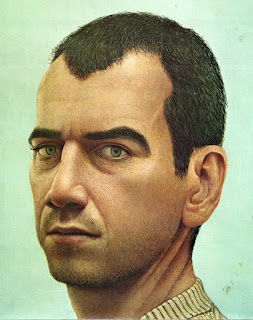 |
| Vincent |
I also painted a background, using a geometric composition. I enjoy juxtaposing the patterns of his clothes with that of the geometric background. As well as the patterns on the pillows. Then the representation of tattoo flash to the right of subject. I like the idea that tattooed people are 'patterned skin'.
This presented an epiphanic moment to me. A visual theme I want to include and consider will be patterns. How visual patterns direct/affect the viewer.
Along with experimenting with the visual effects of spit-shaded liquid acrylic, I've been trying to tie in the actual process of tattoo in my work.
I've considered painting on other materials as well as unconventional material such as the porcine casings. Although I have gotten some satisfying effects of drying porcine on paper, to actually spit-shade on it did not produce the desired smoothness that the technique enables on paper. Spit-shading is very specific to its materials, from the paper to the brushes to the liquid acrylics used. It takes awhile to' work in' a brush. And I then primarily stick to four main brushes, until the absolute need to replace, which is met with grief. Maybe its how the spit break-in the brush, maybe its my OCD, either way its specifics such as this that define my process. Interestingly this is also true to some tattooer (myself included). The way in which I would prepare my tools etc for a tattoo was very specific, ritualistic. This ritual was essential.
So I am continuing on the same watercolor paper, as well as figuring out how I want to interpret tattoo. While on a search for actual parchment I was directed to a leather shop. Considering the option of possibly painting leather, I also was introduced to large rawhide sheets. When soaked the rawhide becomes malleable. I bought some leather and rawhide.
Conceptually working in these materials is great, being that they are both skins of animals. I asked the very friendly leather salesman in he ever heard of tattooed rawhide, to which he said if he could figure out how to do it he would make a bunch o money. he said unfortunately the rawhide will 'blow out the ink and not hold the line'....... malleable
 |
| Dry rawhide |
What I tattoo and how the tattooed rawhide I use in the painting will work on different levels, both visually and conceptually.
The lines and shading are imperfect, as rawhide differs from living skin. I actually like this idea as well. Nevertheless, as stated before, there is mark making. Even if some lines spread into the veins of the rawhide, I like the possibilities with that as well.
 |
| Self-portrait |
The above is the first attempt of incorporating everything I've been working on thus far. The bodice thing is the tattooed rawhide, of which a tessellation pattern was tattooed. The rawhide then dried and adhered to the painting, which was done on watercolor paper, which was cut out and adhered to a photograph , which is adhered to a pre-fab board. The rawhide also adds physical dimension, as it is about a centimeter thick. This allows for pieces to be cut out, like the center circle with a traditional tattooed rose inside it. With this centimeter thick boarder around the rose I was able to fill that with resin. The outcome makes rose look more ornamental, an aspect of the painting that is given a kind of 'sacred housing'.
I intend to do more along these lines. Pushing my technique both of spit-shading and tattooing rawhide. Hopefully joining them in compositionally interesting collages.

































